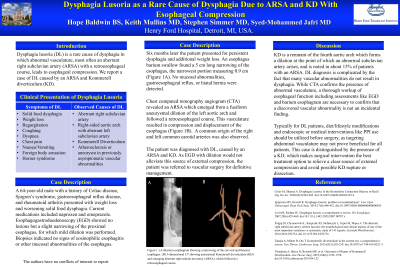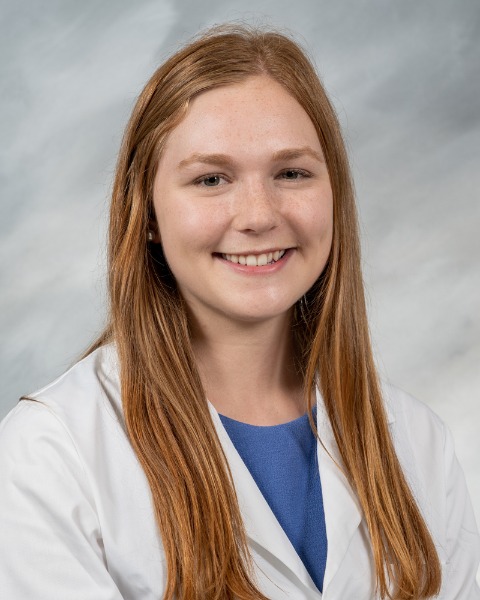Back


Poster Session E - Tuesday Afternoon
Category: Esophagus
E0243 - Dysphagia Lusoria as a Rare Cause of Dysphagia Due to ARSA and KD With Esophageal Compression
Tuesday, October 25, 2022
3:00 PM – 5:00 PM ET
Location: Crown Ballroom

Has Audio

Hope Baldwin, BS
Wayne State University School of Medicine
Detroit, Michigan
Presenting Author(s)
Hope Baldwin, BS1, Syed-Mohammed Jafri, MD2, Keith Mullins, MD2, Stephen Simmer, MD2
1Wayne State University School of Medicine, Detroit, MI; 2Henry Ford Health System, Detroit, MI
Introduction: Dysphagia lusoria (DL) is a rare cause of dysphagia in which abnormal vasculature, most often an aberrant right subclavian artery (ARSA) with a retroesophageal course, leads to esophageal compression. We report a case of DL caused by an ARSA and Kommerell diverticulum (KD).
Case Description/Methods: A 64-year-old male with a history of Celiac disease, Sjogren’s syndrome, gastroesophageal reflux disease, and rheumatoid arthritis presented with weight loss and worsening solid food dysphagia. Current medications included naproxen and omeprazole. Esophagogastroduodenoscopy (EGD) showed no lesions but a slight narrowing of the proximal esophagus, for which mild dilation was performed. Six months later the patient presented for persistent dysphagia. An esophagus barium swallow found a 5 cm long narrowing of the esophagus, the narrowest portion measuring 0.9 cm (Figure 1A). No mucosal abnormalities, gastroesophageal reflux, or hiatal hernia were detected. Chest computed tomography angiogram (CTA) revealed an ARSA which emerged from a fusiform aneurysmal dilation of the left aortic arch and followed a retroesophageal course. This vasculature resulted in compression and displacement of the esophagus (Figure 1B). The left subclavian artery also arose from the dilation, and a common origin of the right and left common carotid arteries was observed. The patient was diagnosed with DL, caused by an ARSA and KD. As EGD with dilation would not alleviate this source of external compression, the patient was referred to vascular surgery for definitive management.
Discussion: KD is a remnant of the fourth aortic arch which forms a dilation at the point of which an abnormal subclavian artery arises, and is noted in about 15% of patients with an ARSA. DL diagnosis is complicated by the fact that many vascular abnormalities do not result in dysphagia. While CTA confirms the presence of abnormal vasculature, a thorough workup of esophageal function including assessments like EGD and barium esophagram are necessary to confirm DL diagnosis. Typically for DL patients, diet modifications and endoscopic or medical interventions like PPI use should be utilized before surgery, as targeting abdominal vasculature may not prove beneficial. This case is distinguished by the presence of a KD, which makes surgical intervention the best treatment option to relieve a clear source of external compression and avoid possible KD rupture or dissection.

Disclosures:
Hope Baldwin, BS1, Syed-Mohammed Jafri, MD2, Keith Mullins, MD2, Stephen Simmer, MD2. E0243 - Dysphagia Lusoria as a Rare Cause of Dysphagia Due to ARSA and KD With Esophageal Compression, ACG 2022 Annual Scientific Meeting Abstracts. Charlotte, NC: American College of Gastroenterology.
1Wayne State University School of Medicine, Detroit, MI; 2Henry Ford Health System, Detroit, MI
Introduction: Dysphagia lusoria (DL) is a rare cause of dysphagia in which abnormal vasculature, most often an aberrant right subclavian artery (ARSA) with a retroesophageal course, leads to esophageal compression. We report a case of DL caused by an ARSA and Kommerell diverticulum (KD).
Case Description/Methods: A 64-year-old male with a history of Celiac disease, Sjogren’s syndrome, gastroesophageal reflux disease, and rheumatoid arthritis presented with weight loss and worsening solid food dysphagia. Current medications included naproxen and omeprazole. Esophagogastroduodenoscopy (EGD) showed no lesions but a slight narrowing of the proximal esophagus, for which mild dilation was performed. Six months later the patient presented for persistent dysphagia. An esophagus barium swallow found a 5 cm long narrowing of the esophagus, the narrowest portion measuring 0.9 cm (Figure 1A). No mucosal abnormalities, gastroesophageal reflux, or hiatal hernia were detected. Chest computed tomography angiogram (CTA) revealed an ARSA which emerged from a fusiform aneurysmal dilation of the left aortic arch and followed a retroesophageal course. This vasculature resulted in compression and displacement of the esophagus (Figure 1B). The left subclavian artery also arose from the dilation, and a common origin of the right and left common carotid arteries was observed. The patient was diagnosed with DL, caused by an ARSA and KD. As EGD with dilation would not alleviate this source of external compression, the patient was referred to vascular surgery for definitive management.
Discussion: KD is a remnant of the fourth aortic arch which forms a dilation at the point of which an abnormal subclavian artery arises, and is noted in about 15% of patients with an ARSA. DL diagnosis is complicated by the fact that many vascular abnormalities do not result in dysphagia. While CTA confirms the presence of abnormal vasculature, a thorough workup of esophageal function including assessments like EGD and barium esophagram are necessary to confirm DL diagnosis. Typically for DL patients, diet modifications and endoscopic or medical interventions like PPI use should be utilized before surgery, as targeting abdominal vasculature may not prove beneficial. This case is distinguished by the presence of a KD, which makes surgical intervention the best treatment option to relieve a clear source of external compression and avoid possible KD rupture or dissection.

Figure: Figure 1. (A) Barium esophagram showing a narrowing of the cervical and thoracic esophagus. (B) 3-dimensional CT showing aneurysmal Kommerell diverticulum (KD) and emerging aberrant right subclavian artery (ARSA), which followed a retroesophageal course.
Disclosures:
Hope Baldwin indicated no relevant financial relationships.
Syed-Mohammed Jafri indicated no relevant financial relationships.
Keith Mullins indicated no relevant financial relationships.
Stephen Simmer indicated no relevant financial relationships.
Hope Baldwin, BS1, Syed-Mohammed Jafri, MD2, Keith Mullins, MD2, Stephen Simmer, MD2. E0243 - Dysphagia Lusoria as a Rare Cause of Dysphagia Due to ARSA and KD With Esophageal Compression, ACG 2022 Annual Scientific Meeting Abstracts. Charlotte, NC: American College of Gastroenterology.
